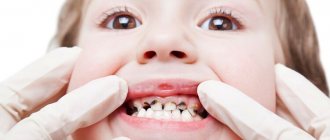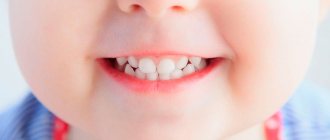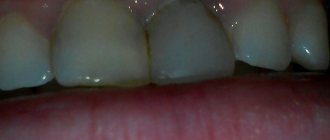At 2.5-3 years old, the child already has all his milk teeth. Natives will replace them by about 12 years of age. In this case, caries can develop on both temporary and permanent teeth. It needs to be treated in both cases. In this article we will tell you why caries occurs in children under 3 years of age, how it manifests itself and how it is treated.
The timing of teething may vary depending on full term, health status, phosphorus-calcium metabolism, nutrition and a number of other factors. For some children, their first teeth appear at 5.5-6 months, for others - at about a year. They erupt in pairs: the first are the incisors, then the chewing teeth and canines.
In this article
- Causes of caries in children under 3 years of age
- Factors for the occurrence of caries in children under 3 years of age
- How does caries manifest itself in children?
- Types of caries
- What is bottle caries of baby teeth?
- How to treat caries in a child
- How to treat caries in children at the following stages
- How to prepare your child for treatment
First, the lower front teeth are cut, followed by the upper ones, after about 1.5-2 months. By 9-11 months, the upper lateral incisors erupt, and by 12-13 months, the lower ones. Thus, with normal development of a child, by the end of the first year of life he should have 8 teeth: four on the bottom and four on top.
The subsequent growth of the baby requires chewing skills from him, so the molars begin to cut. They grow simultaneously on the lower and upper jaw. By 16 months, a child’s mouth already has 12 teeth.
After this, the fangs erupt; due to their massiveness, they are the most difficult to cut. The upper ones appear first, and after a couple of months the lower ones appear. The second molars are the last to grow. All milk teeth (20 pieces) completely erupt by 2.5-3 years.
Next, the replacement of baby teeth with molars begins. This process lasts up to about 12 years, and without taking into account “eights” or wisdom teeth. This physiological process occurs in all people: for some it is faster, for others it is slower. For certain reasons, delays are possible, but sooner or later all baby teeth will fall out and molars will grow in their place.
This will happen faster and without associated problems if you monitor the child’s oral cavity. Dental diseases, including tooth decay, can occur at any age. Carious lesions also develop on baby teeth. Leaving this pathology untreated is dangerous: there is a risk of jaw infection, gum infection and the development of other complications, including systemic infections. Let's tell you why caries appears in a 3-year-old child.
Causes of caries in children under 3 years of age
The main cause of caries in children is cariogenic microorganisms. First of all, bacteria from the group of acid-forming streptococci, for example, Streptococcus mutans, Streptococcus viridans, etc.
They are characterized by anaerobic fermentation and the release of acids - lactic, formic, butyric and propionic, which corrode the enamel, causing its demineralization. It becomes less calcium, phosphorus, magnesium and other minerals. The gradual destruction of enamel leads to dentin exposure, and carious cavities form in the tooth.
All adults have cariogenic microbes and are part of our microflora. Children can get this bacteria from adults through kissing, eating utensils or a pacifier. As a rule, this happens during feeding: the mother checks the temperature of the baby’s food, tasting it from a spoon, and then puts it into the baby’s mouth. Together with the saliva of an adult, various bacteria enter his mouth, including those that cause caries.
Another typical situation is when the mother sucks on the pacifier if the baby drops it on the floor and then gives it to the baby again. Doctors recommend never doing this, and this is not only about caries, but also about other dangerous diseases. The oral cavity of an adult contains many microorganisms to which fragile children's immunity is vulnerable. There is a risk of the child contracting systemic infections.
Cariogenic microbes are the main culprits in the development of caries, but they are not the only ones. In addition to bacteria, there are a huge number of factors that increase the likelihood of developing caries in children under 3 years of age. Let's take a closer look at them.
Why do baby teeth hurt?
The fact that dental treatment is necessary at any age is irrefutable. But why do kids get toothache so often? There are several explanations for this, and they all have to do with the structural features of children's teeth. This means:
- Very thin and insufficiently mineralized enamel. It cannot withstand the aggressive influence of sugar, traumatic damage, or mechanical stress. It is easily destroyed by the accumulation of soft plaque, in which pathogenic microorganisms actively multiply. It is because of this that in children, caries in the form of a spot can turn into a huge “hollow” in a few weeks. Then the deep layers of the child, pulp, and nerve endings become involved in the destructive process.
- Quite thin dentin. This promotes the rapid transition of bacteria from the external tissues of the tooth to the internal ones.
- Large pulp volume. It can be considered as suitable conditions for the spread of pathogens.
Most often, doctors diagnose caries in children. If you treat it immediately after the appearance of a white or dark spot, the prognosis will be favorable. Most likely, the unit will remain until it is pushed out by a more durable permanent replacement. If you let the carious process take its course, within six months or a year the destruction will become so extensive that it will have to be removed.
Factors for the occurrence of caries in children under 3 years of age
There are three groups of factors: a woman’s poor lifestyle during pregnancy, local and general. If a mother does not monitor her diet during pregnancy, abuses alcohol, smokes, and does not visit doctors, the likelihood of a baby being born with various diseases increases.
Of course, he will not have caries from birth, but it can develop after teething, for example, due to a lack of minerals in the body. A pregnant woman should lead a healthy lifestyle and include the following foods in her diet: milk, cottage cheese, nuts, fish, meat, liver, legumes, berries, fruits, chicken eggs and cereals.
Among the external factors for the development of caries in children:
- Poor hygiene. Children don't like to brush their teeth. At first, adults do this for them; at about a year old, children begin to learn to clean themselves. If the baby neglects this hygienic procedure, plaque accumulates on his teeth, which gradually turns into tartar. It is a favorable environment for the proliferation of cariogenic microbes.
- Impaired saliva production. Saliva contains substances that neutralize acids produced by bacteria. If the salivary glands do not work well, producing insufficient amounts of saliva, demineralization of the enamel occurs faster.
- Malocclusion. If a child’s teeth grow in different directions and the bite develops incorrectly, more hard-to-reach places appear in the oral cavity into which microbes penetrate.
- Consumption of large amounts of sweets. Cariogenic bacteria feed on carbohydrates. The fermentation process begins in the oral cavity. Sucrose is the most dangerous for humans, fructose is less dangerous.
Common factors for caries in children include:
- cardiovascular diseases;
- problems with the gastrointestinal tract;
- weak immunity;
- bad ecology;
- stress.
Dental caries in children occurs due to the influence of several factors on the body. In children, tooth enamel is just developing. It takes 2-3 years for teeth to become stronger. They are more vulnerable to germs. In addition, children often eat sweets. All this leads to the development of caries.
Do they give anesthesia to children?
Many parents are concerned about how to painlessly treat teeth in children under 5 years old.
Non-invasive methods are absolutely painless. If a cavity needs to be prepared, anesthesia may be required. Children most often undergo two-stage anesthesia. First, the gum area is treated with an anesthetic gel, which numbs the injection site, and then an anesthetic injection is given.
In some cases, it is advisable to use sedation - when the child is introduced into a relaxed state of half-asleep using a special gas. Choosing the optimal method of pain relief and treatment is the responsibility of the dentist.
How does caries manifest itself in children?
The clinical picture of caries in children and adults is the same. The disease develops in four stages, each of which has its own symptoms. Treatment is selected based on the degree of pathology. Let's take a closer look at each stage.
- First (initial). First, a white or chalky spot appears, which indicates demineralization of the enamel. The affected area of the tooth can only be detected during an examination. The pathology does not manifest itself in any way. The person does not experience discomfort or pain. Increased sensitivity of enamel and gums is not observed. Bacteria continue to multiply and eat away at the enamel, making it loose and soft. At this stage, caries can be cured without preparation; it is enough to restore the balance of minerals in the body and on the surface of the tooth.
- Second (superficial). If caries is not treated at the first stage, it progresses to the second, which is characterized by the penetration of the carious process into the dentin. The chalk stain takes on a brown or yellowish tint. The internal tissues of the tooth begin to be exposed. However, at this stage, caries can still be stopped with the help of therapeutic treatment. The disease can be easily detected by signs such as tooth hypersensitivity to sweet, hot and cold foods. After eliminating the irritant, the pain immediately disappears.
- Third (medium caries). If left untreated, superficial caries penetrates deeper into the dentin. The carious cavity grows. Toxins released by cariogenic microbes enter microcracks in hard tissues. Demineralized areas of enamel turn brown and are easily visible to the naked eye. Externally, a carious cavity looks like a cone with the tip inside the tooth and the base on its surface. At this stage, the nerve is not affected, but the person feels acute pain when brushing the tooth or while eating. Darkened tissue indicates a rotting process, which causes bad breath.
- Fourth (deep). Further spread of caries leads to large-scale damage to hard tissues; the pulp is separated from the pathological cavity by a thin septum. At any moment, a tooth can split into pieces, it often hurts, and the pain cannot be eliminated with the help of analgesics. There is a risk of infection of the soft tissues and jaw. A child may develop a fever due to tooth decay. He sleeps poorly, refuses to eat, and cries constantly.
Symptoms of caries in primary teeth do not differ from signs of caries in primary teeth. Let's talk about the varieties of this pathology.
Peculiarities
Babies' first teeth appear at one year of age. By the age of three, they have grown a full set of them.
They have their own characteristics:
- thin enamel layer;
- loose structure of dental and gum tissue;
- undeveloped local immunity;
- high degree of tissue vascularization.
For these reasons, children's teeth and gums are more susceptible to the pathological effects of bacteria. Inflammatory processes occur faster in them, infection spreads faster, and complications occur more often.
Types of caries
Children under 3 years of age cannot develop only dental root caries; other types of this disease do not depend on age. It takes various forms - acute or chronic. In the first case, the carious process progresses rapidly; within a few weeks, the pathology passes through all four stages. It is accompanied by severe pain, which is not helped by analgesics.
Chronic caries is painless. However, it can develop over months and years, gradually destroying hard dental tissues. Often the carious process spreads to neighboring teeth. In such cases it becomes multiple.
Based on localization, caries is divided into cervical (near the gums), interdental and fissure (in the pits on the chewing surface). Dentists also often use the classification proposed by the American doctor Green Black. It allows you to determine the stage of caries and select a treatment method. Black divided this disease into classes:
- Carious lesions are localized in the fissures of the teeth.
- Pathology affects the contact surface of premolars and molars.
- Caries of the anterior teeth, localized on the contact surface of the canines and incisors.
- The pathological focus is located on the front teeth, the integrity of the cutting edge is compromised.
- Caries covers the vestibular surfaces of the tooth.
- Carious lesions are located on the cutting parts of the incisors and in the fissures of the molars.
With the help of instrumental diagnostics, the doctor can detect caries at any stage. Each of them is treated using different methods. Let us consider separately another type of carious process that develops on the front teeth. After this, we will tell you how caries is treated in children.
How do children's teeth work?
Children have an order of magnitude smaller teeth than adults. In addition, they are much smaller in size than permanent ones, are less durable, and are easily susceptible to the destructive influence of caries.
Pulp - loose fibrous tissue that fills the internal cavity of the tooth - occupies a very large space and is covered with a relatively thin protective layer. It is where blood vessels and nerve endings pass. This means that there are nerves in baby teeth and they can hurt no less than molars.
As for the characteristics of the root system, it is less developed in children than in adults. This is due to the need for root resorption during the period of change of bite .
Dentists never tire of repeating: baby teeth are complex systems in structure, and their condition affects the health of future molars. This is why most people who ignore the need to visit the dentist in childhood have serious dental problems at a young age.
Many parents do not pay enough attention to the health of their children's smiles. They explain their position by the fact that very soon the roots will resolve anyway, and the crown will collapse. But thinking like that is irrational and even dangerous. The inflammatory process can move to the root germ, then there is no need to talk about any healthy change.
Moreover, it is inhumane to deny children dental treatment. Indeed, with severe tissue destruction, they will begin to experience unbearable pain. If you treat caries at an early stage of its development, serious problems are guaranteed to be avoided.
What is bottle caries of baby teeth?
Bottle caries can occur almost immediately after teething if the baby is bottle-fed and cariogenic bacteria enter the newborn’s oral cavity. They begin to eat milk, which has a lot of sugar. The mouth creates a favorable environment for the proliferation of microbes. Since the incisors appear first, caries of the front teeth occurs. It develops in exactly the same way as other varieties of this pathology. Complications may arise if parents do not bring the baby to the dentist for examination.
How to treat caries in a child
The method of treating caries in children is determined by the stage of the disease. If it is detected at the very beginning, silvering, remineralization or ozone therapy is prescribed.
Silvering is a minimally invasive and painless method of treating caries, which consists of applying a silver solution with a cotton swab to the surface of a tooth affected by caries. The silver composition has an antibacterial effect and is good at destroying cariogenic microbes. This method has a significant drawback. After silvering, tooth enamel darkens without the ability to restore its natural shade. You'll have to wait for the molars to grow in.
Remineralization is a procedure for saturating enamel with minerals. The method is effective at the stage of a white spot, onto which compositions with calcium, magnesium and phosphorus are applied. Several sessions are required to completely restore the surface of the tooth. In order to quickly introduce microelements into the enamel, ultrasound, electrophoresis or vacuum are used.
Ozone therapy is one of the most modern methods of caries treatment, in which ozone is applied to the tooth through a small silicone cup. It sterilizes the carious cavity. This procedure, which lasts only a few minutes, ends with remineralization.
How to treat caries in children at the following stages
Treatment of medium and deep caries is carried out through filling, depophoresis and preparation. Fillings are installed using materials that are softer in structure than teeth. Silicophosphate cements are usually used. Today they can also install a filling with fluoride: gradually it will move into the dental tissue and become part of it. Sometimes doctors use colored materials and even polymers with glitter to distract the child from the procedure itself.
Depophoresis is a method of treating dental canals in hard-to-reach places. The dentist injects a solution of copper and calcium into the carious cavity and carries out disinfection.
Preparation is the most common method of combating caries, during which the tooth is cleaned of necrotic tissue. The procedure is carried out by exposing the tooth to a powerful stream of water or air. sometimes with abrasive particles. After this, a seal is applied to the cleaned surface.
Treatment of childhood caries is carried out under local anesthesia. General anesthesia is used very rarely: only in cases where its use is really advisable.
Dental treatment under anesthesia
In most cases, treatment is carried out after the introduction of anesthesia, which is divided into two types - application with local application of medication and injection, which involves the administration of an injection. The second option is safer and more effective.
If a child has panic fear or is simply restless, anesthesia is used, but before using it, a number of diagnostic measures are prescribed:
- biochemical blood test;
- general blood and urine tests;
- blood to determine sugar levels;
- electrocardiography to assess the state of the heart.
You should not eat food 5–6 hours before anesthesia, and drink water and other liquids 4 hours before.
Sleep is induced very gradually using sevoflurane-based gas. If the child needs to be woken up, the doctor increases the amount of oxygen supplied, and this can be done at any time. After waking up, all reflex functions are fully restored within the first 15 minutes. As a rule, there are no complications.
How to prepare your child for treatment
It's no secret that children are afraid of dentists, and without reason. Today, dental procedures are performed quickly and painlessly. You just need to prepare your baby for treatment so that he doesn’t worry. Find a good specialist. Some doctors turn the treatment process into an interesting game and thereby distract the child from terrible thoughts.
Practice your visit to the dentist at home. Soft toys can also act as “patients”. Tell your child that both mom and dad go to the dentist. Choose a time to visit the clinic when your baby is alert and cheerful. Make up a story about how a doctor saves teeth from monsters. Never scare children with hospitals or doctors when they misbehave.
Check your child's teeth every few months. Get him used to brushing them twice a day. Buy a special children's brush with soft bristles. To make it more interesting for him to take care of his teeth, you can choose a brush stylized as a cartoon character. Similar hygiene products are available in our online store.










